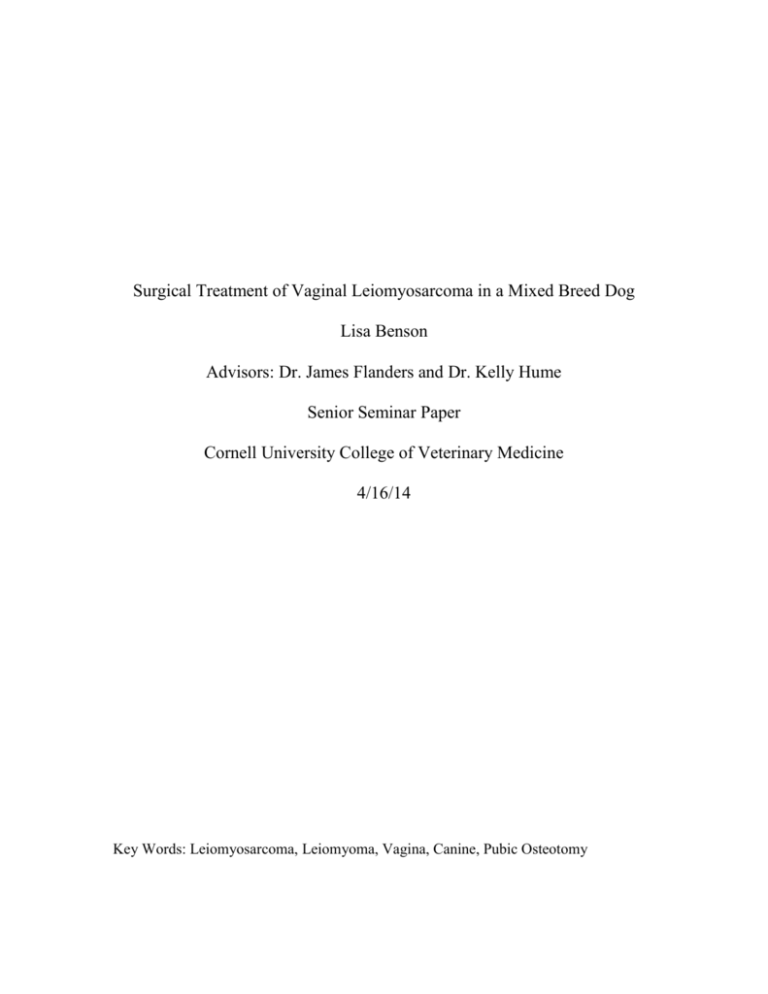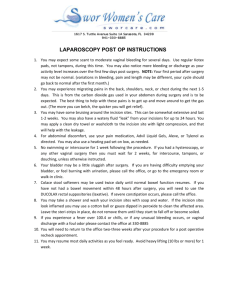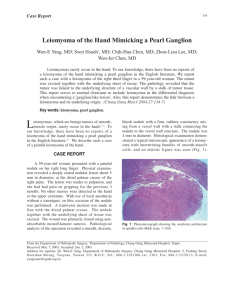Benson-Lisa-Paper 2014 - eCommons@Cornell
advertisement

Surgical Treatment of Vaginal Leiomyosarcoma in a Mixed Breed Dog Lisa Benson Advisors: Dr. James Flanders and Dr. Kelly Hume Senior Seminar Paper Cornell University College of Veterinary Medicine 4/16/14 Key Words: Leiomyosarcoma, Leiomyoma, Vagina, Canine, Pubic Osteotomy Abstract An 11 year old mixed breed spayed female dog was presented to the Cornell University Hospital for Animals Soft Tissue Surgery Service with a two week history of tenesmus and cough. A mass localized to the colon by her primary veterinarian via external abdominal palpation was first detected four months prior and had rapidly grown in size. During the same time period, rapidly progressive right hind limb lameness developed. Digital rectal palpation revealed an intrapelvic mass, which effectively obstructed her rectum. A full body CT scan was negative for metastasis and confirmed a vaginal mass as the cause of the patient’s tenesmus as well as the patient’s associated right hind limb lameness. After successful excision of the vaginal mass, histopathological analysis confirmed a diagnosis of leiomyosarcoma and a likely curative complete excision. Introduction Vaginal tumors are uncommon in dogs. Tumors of the vulva and vagina account for only 2.4 – 3% of all reported canine neoplasms. Of these, 83% are reported as benign smooth muscle tumors, the most common being leiomyoma. Leiomyoma is usually found in intact females with an average age of 10.8 years1. The incidence of leiomyoma is higher in intact nulliparous bitches2. Several studies present data which indicate that vaginal leiomyoma growth is affected by sex steroids, as it has been documented in human literature2,3,4,5,6,7. Leiomyosarcoma is the most common malignant canine vaginal neoplasia, and distant metastases have been reported. It is more commonly found in the 1 gastrointestinal tract than the vagina, and generally has a moderate metastatic risk depending on the primary location of the tumor8. Vaginal leiomyosarcoma is less common in dogs compared to gastrointestinal or splenic leiomyosarcomas. Unlike the benign vaginal leiomyoma, which is seen in intact females, it has been reported in spayed females. Leiomyosarcoma is a malignant soft tissue sarcoma of smooth muscle origin8. It appears grossly similar to the benign smooth muscle tumor, leiomyoma. Definitive diagnosis differentiating between these two requires histopathological analysis. The differentiation between the two diagnoses may be challenging due to a lack of cases and is generally based on severity of mitotic index, necrosis, ischemic change, invasiveness, and cellular atypia7. This paper describes the clinical signs, diagnosis, and surgical treatment of a vaginal leiomyosarcoma in a spayed mixed breed dog. Case History An 11 year old female spayed mixed breed dog weighing 29.3 kg (64.5 lb) was presented to the Cornell University Hospital for Animals Soft Tissue Surgery Service with the following problems listed in chronological order: chronic, mild, bilateral hind limb lameness, a four month history of a mass localized by the referring veterinarian via external abdominal palpation to the colon, a four month history of progressive right hind limb lameness, a two week history of severe tenesmus which prompted the presentation to the soft tissue surgery service, and a two week history of cough. The tenesmus had not improved despite oral lactulose administration (15 ml PO TID = 341 mg/kg PO TID) for the three days prior to presentation. 2 The chronic, mild, bilateral hind limb lameness had not progressed or interrupted the patient’s daily activities or energy level, and had not historically been a concern to the referring veterinarian or the client. The key presenting complaint of primary concern to all was a two week history of severe tenesmus. Four months prior to presentation, the referring veterinarian had palpated an approximately 2 cm diameter mass, which was localized to the colon via external abdominal palpation. Diagnostic imaging was not pursued at this time, however a complete blood count and blood chemistry were performed at that time by the referring veterinarian and were unremarkable. During the course of the ensuing four months the mass had grown in diameter to approximately 5 cm. This same mass was presumably the cause of the patient’s tenesmus. The owner also noted progressive right hind limb lameness over the course of the four months prior to presentation. At the time of presentation to the soft tissue surgery service, the owner complained of marked tenesmus, right hindlimb lameness, and cough. The patient had no previous history of illness before the presentation of the mass four months prior, nor did she experience complications with the ovariohysterectomy performed over 10 years prior to presentation, when she was less than six months old. Clinical Findings At presentation, the patient appeared severely anxious and was reactive to touch, or the anticipation of touch to the caudal half of the trunk and hind limbs. No external swelling or mass was visible at the rectum, vulva, perineum, or abdomen. The right hind limb laterally deviated on ambulation, which appeared as “swinging” the leg laterally at 3 the walk and the jog, as well as holding the leg away from the trunk cranio-laterally when sitting and recumbent. A round, firm, mobile subcutaneous mass 3 cm in diameter, was palpated at the caudal aspect of the left hind limb. No coughing was noted at the time of the physical examination. Complete blood count and blood chemistry were unremarkable. At this time, the differential diagnoses list for this patient is extensive, including an abscess or neoplasia arising from any of the normal anatomy of the pelvis. Examples of differential diagnoses include granuloma, as the result of a stump pyometra (ovarian remnant syndrome), carcinoma, adenocarcinoma, fibroma, fibrosarcoma, mast cell tumor, leiomyoma, leiomyosarcoma, transmissible venereal tumor, hemangioma, hemangiosarcoma, squamous cell carcinoma, and malignant lymphoma. Many of these examples are uncommon for this location in canines. Nevertheless, the list of differential diagnoses could not be reduced without further diagnostics including advanced imaging to help localize and characterize the mass. The patient was anesthetized for a full body computed tomography (CT) scan, which confirmed a large, focal, well-defined, intrapelvic mass as the cause of the patient’s inability to defecate. It was found to displace and compress the rectum leftdorsally, displace the urethra ventrally, and was continous with the vagina. The mass appeared to arise from the vagina, not the colon or rectum. Sciatic nerve compression was noted as a potential source for right pelvic limb pain. Bilateral hip osteoarthrosis was noted as mild and provided an explanation for the patient’s chronic, mild bilateral hind limb lameness, but was considered to be an unlikely cause of the more severe pain noted at presentation. The subcutaneous mass of the left thigh was found to be an incidental lipoma. 4 While under general anesthesia, digital rectal palpation was performed and revealed a large, rounded, firm mass along the right ventro-lateral aspect of the pelvic canal, which effectively obstructed her rectum. The left ischium was also immediately palpated at the left aspect of her pelvic canal, demonstrating the previously noted deviation of the lumen of the rectum as the result of the presence of the large intrapelvic vaginal mass. A biopsy of her mass, obtained through the lumen of the rectum during digital rectal examination was also performed at this time and was inconclusive on preliminary cytology. Prior to further diagnostics, an extensive list of differential diagnoses included an abscess or neoplasia arising from any of the normal anatomy of the pelvis: the rectum, the vagina, the bony pelvis, and the urethra. Following localization of the mass to the vagina via computed tomography, primary differential diagnoses were reduced to two forms of neoplasia: either the benign leiomyoma or the malignant leiomyosarcoma,. The primary inflammatory differential diagnosis, a granuloma resulting from “stump pyometra”, was unlikely due to the fact that the patient was spayed by six months of age, over 10.5 years prior, with no signs of ovarian remnant in the time since her ovariohysterectomy. Thus, the primary differential diagnoses were limited to leiomyoma or meiomyosarcoma. The final definitive diagnosis required histopathological analysis. The treatment of choice for each primary differential diagnosis is the same: surgical mass excision. Due to the unremarkable blood work, lack of metastases, and well-defined nature of the reconstructed images of the intrapelvic mass, the patient was considered a good candidate for surgery and surgical mass excision was planned for the following day. 5 Treatment Surgery began with an episiotomy, in an effort to excise the mass with minimal trauma to the nerves and other tissue of the pelvis in as minimally invasive an approach as possible. The patient was surgically prepared for an abdominal approach as well, should the mass require an abdominal laparotomy and pubic osteotomy to remove the intrapelvic mass. A standard approach to an episiotomy was performed with a standard full thickness incision9. The caudal aspect of the mass was located and partially visualized in the vaginal canal. However, the mass was located too far cranially to be removed using this approach. The episiotomy incision was closed in standard three layer fashion and the patient was then placed in dorsal recumbency and prepared in standard sterile fashion for an abdominal laparotomy. A standard caudal abdominal approach was made, after which the bladder, ureters, uterine stump, and associated nerves were visualized. The mass was localized and surrounding tissue was dissected away to confirm the mass was within the lumen of the vagina and of vaginal origin. However, it was apparent that a pubic osteotomy was required to provide access to the full mass and enable the complete excision of the mass. The adductor and gracilis muscles were transected at their point of origin along the pubic symphysis, and the right and left arms of the pubic bone were then carefully transected. The cranial aspect of the pubic symphysis was then transected in a perpendicular line to the original two transections, and the central portion of the pubic 6 bone including the pubic symphysis was reflected caudally. Within the pelvis, the ventral vaginal wall was incised and reflected to reveal the mass. The mass was carefully excised from the vaginal wall. Attention was given to attempt to avoid causing trauma to the associated nerves of the pelvis. The hypogastric, pelvic, and pudendal nerves as well as the pelvic plexus were visualized. All together, these nerves supply the sympathetic and parasympathetic innervation to the bladder, urethra, and external urethral sphincter10. The tissue surrounding these nerves associated with the mass were meticulously dissected in an attempt to prevent potentially permanent post surgical complications including urinary or fecal incontinence. After excision of the mass, the remaining defect in the vaginal wall as well as a small defect in the rectal serosa was repaired before the pubic bone was realigned and closed with 22 gauge orthopedic wire using the circlage technique. The adductor and gracilis muscles were reattached to the pubic symphysis and the abdomen was flushed with warm lavage before closing in standard fashion. The patient recovered from anesthesia without complication and the mass was submitted for histopathological analyisis. After surgery, the patient received standard post surgical care in the intensive care unit. This included intravenous antibiotic (clindamycin 11 mg/kg BID) as well as pain management. Antibiotic medication was indicated as a prophylactic post-laparotomy measure in the event of potential rectal wall perforation. Though we did not visualize any gut wall perforations during the surgery, we could not confirm this until we concluded surgery. Furthermore, we had been dissecting tissue surrounding and including the wall of the rectum throughout the surgery. Some of this rectal serosal tissue had already been 7 compromised prior to surgery by the presence of the tumor. Antibiotic administration was begun in this patient prior to surgery and continued perioperatively until two weeks post surgery. Clindamycin was chosen for it’s good coverage of anaerobic bacteria, which are of particular concern in the event of rectal wall compromise. Pain management included: intravenous fentanyl CRI 2 mcg/kg/hr, intravenous dexmedetomidine (0.5 mcg/kg) as needed q 4 hours) and a one time subcutaneous 24 hour dose of carprofen (4.4 mg/kg). A 75 mcg fentanyl patch was placed post operatively so that it would be active the next day. Once the patient was eating, oral pain medications were administered which included carprofen (2 mg/kg PO BID), gabapentin (3 mg/kg PO BID), and tramadol (3 mg/kg PO as needed q 8 hours). The patient was weaned off of intravenous medications. Throughout the patient’s recovery beginning directly after surgery, additional supportive care included intravenous fluids, icing of the incision, checking the bandage every 6 hours, and regularly monitoring the patient for pain or other abnormalities including abnormalities in urination. The primary concern for this patient post operatively was the surgical complication of urinary incontinence. However, within 24 hours the patient produced a steady, controlled stream of urine and demonstrated good bladder control. She was discharged to her owners 24 hours after surgery with the oral pain medications (described above) as well as a prescription for two weeks of the antibiotic clindamycin (7.7 mg/kg PO BID). Pathological Findings A moderately cellular, well-demarcated, expansile mass was described histopathologically. The mass was composed of spindle cells which were often 8 arranged at irregular, acute angles, thus creating a generalized disorganization which is consistent with the irregular orientation of neoplastic cells. Cellular pleomorphism, including anisocytosis and anisokaryosis were noted. Areas of necrosis and ischemic change were also noted. The mitotic index was originally read out at 1 mitotic figure per 10 high powered fields, but later was re-examined and determined to be approximately 3 mitotic figures per 10 high powered fields. While this remains a relatively low mitotic index, it is subjectively higher than the typical mitotic indexin a benign leiomyoma. Cytologic features such as pleomorphism, rate of mitosis, and invasiveness help in determining whether a tumor is the benign leiomyoma or the malignant leiomyosarcoma7. The mitotic index, areas of necrosis and ischemic change, and the cellular atypia were the basis for the diagnosis of leiomyosarcoma. Data is limited for vaginal leiomyosarcomas and therefore an assessment is also partially dependent on the experience of the pathologist. In this case, the combination of mitotic activity, cellular atypia and large areas of ischemic change and necrosis warranted a diagnosis of a low grade leiomyosarcoma. Despite these factors, the mass appeared well demarcated. The presence of normal muscle cells identified along the entire circumference of the tumor demonstrated a likely complete excision. Outcome/Discussion Two weeks post surgery, the owners reported that the patient was experiencing tenesmus . This patient was no longer receiving oral lactulose at the time. After administration of lactulose (341 mg/kg PO BID), and supplementing the 9 diet with canned pumpkin, the tenesmus resolved. One episode of diarrhea followed an accidental overdose of lactulose, but the patient has had no subsequent issues and has urinated and defecated normally throughout the eight weeks since this episode. The owners report that the patient has a good appetite and energy level, with no signs of pain or illness. The owners also report that the patient is able to maintain bladder control for 7 hours at a time. Her current lactulose dose of one teaspoon every 12 hours (0.11 mg/kg PO BID) is most likely unnecessary, but is administered due to owner preference. As previously stated, canine vaginal leiomyosarcomas are uncommon. Gastrointestinal and splenic leiomyosarcomas are more commonly seen., Biologic behavior seems to vary by location. For example, canine leiomyosarcoma of the liver is considered to have a 100% risk of metastasis while a dermal leiomyosarcoma is considered to have a very low risk of metastasis2. Not enough data exists to provide a figure specifically describing the risk for metastasis of vaginal canine leiomyosarcoma. For other cancer types, a moderate risk of metastasis is generally associated with larger tumors. Radiation therapy and chemotherapy may be pursued as post surgical adjuvant therapies dependent upon whether or not the tumor was completely excised, the location and size of the tumor, mitotic index and other histological characteristics. There is no standard protocol in dogs regarding radiation therapy or chemotherapy for vaginal leiomyosarcoma, although doxorubicin based protocols are commonly used for other sarcomas in dogs Due to limited data, the impact of these therapies on the outcome for vaginal 10 leiomyosarcoma is unknown. Adjuvant therapy would have been recommended if the patient’s histopathology report indicated incomplete excision or more aggressive signs of malignancy. In this case, a complete excision seems to have been attained and there is optimism that surgery was likely curative. References 1. Thacher, CT and Bradley RL. "Vulvar and vaginal tumors in the dog: a retrospective study." J Am Vet Med Assoc. 1983; 183.6: 690-692. 2. Klein, MK. Tumors of the female reproductive system. In: Withrow, SJ, and Vail, DM, eds. Withrow & Macewen's Small Animal Clinical Oncology. 4th ed. St. Louis: Saunders Elsevier, 2007. 610-618 3. Brodey, RS, Roszel JF. Neoplasms of the canine uterus, vagina, and vulva: a clinopathologic survey of 90 cases. J Am Vet Med Assoc. 1967; 151:1294-1307. 4. Kydd DM, Burnie AG. Vaginal neoplasia in the bitch: a review of 40 clinical cases. J Small Anim Pract. 1986; 27: 255-263. 5. Maruo, T, Ohara N, Wang, J, et al. Sex steroidal regulation of uterine leiomyoma growth and apoptosis. Human reprod update. 2004;10(3): 207-220 11 6. Reed, SD, Cushing-Haugen KL, Daling, JR et al. Postmenopausal estrogen and progestogen therapy and the risk of uterine leiomyomas. Menopause. 2004;11(2): 214-22. 7. Schlafer DH, Miller RB. Female genital system. In: Maxie, MG, ed. Jubb, Kennedy, and Palmer's Pathology of Domestic Animals. Vol.3 Edinburgh: Elsevier Saunders. 2007; 429-564 8. Liptak, JM, Forrest, LJ. Soft tissue sarcomas. In: Withrow, SJ, and Vail, DM, eds. Withrow & Macewen's Small Animal Clinical Oncology. 4th ed. St. Louis: Saunders Elsevier, 2007. 425-454. 9. Tobias, KM. Episiotomy. In: Tobias, KM. Manual of Soft Tissue Surgery. Ames: Wiley-Blackwell. 2010; 265-268. 10. Evans, HE, de Lahunta, A., eds. The urogenital system. In: Miller's Anatomy of the Dog. 4th Ed. St. Louis: Elsevier Saunders. 2013; 361-405. 12









